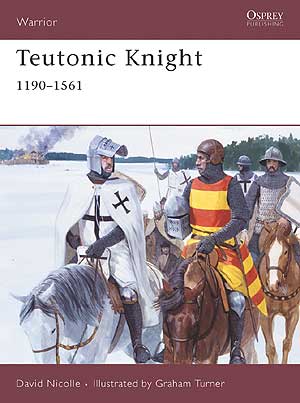
De Re Militari | Book Reviews
David Nicolle
Teutonic Knight 1190-1561
Illustrated by Graham Turner. Warrior 124 (Osprey, 2007), 64pp. ISBN-10: 1846030757; ISBN-13: 978-1846030758. $18.95.

From Osprey’s Warrior series comes this stylish historical overview of the “brother knights” of the Teutonic Order. It is a welcome addition to the altogether too-slim literature in English on the subject, most studies being either in German or aimed at a specialist academic audience. While David Nicolle’s volume naturally functions as an outline of the subject, it manages to incorporate an overview of the order’s history, as well as a remarkably comprehensive survey of its organization, style of warfare, and spiritual outlook. The introduction is the only place which discusses the order’s policy per se, or the logic behind its strategy and campaigns in the Levant and in the Baltic region; the realpolitik aspect of the order can therefore only be generally inferred. As result, the importance of Holy Land to the order (even beyond the official transfer of its headquarters to the Baltic) is somewhat obscured. The narrative concentrates on the Baltic campaigns, and, since the series focuses on the fighting aspects of the order, this is probably to be expected, since it is here that we have the most information and surviving artifacts.
At the front of the book is a useful glossary of terms specific to the Teutonic Order, which non-specialists should find particularly helpful. The only footnotes in the text are to other Osprey titles, but that seems to be a common complaint among De Re Militari reviewers. The maps are useful, mostly sketches; the largest drawback is the map of the Baltic region, which is rather cluttered, and does not clearly label Lake Peipus (although the astute observer might surmise that it is the lake between Novgorod and the Teutonic possessions).
For someone new to Teutonic Order studies, but desirous of learning more, the bibliography should be of special value. It is a fairly comprehensive assembly of the English scholarship, which by count seems to consist of a number of articles in three or four volumes. William Urban’s work naturally dominates the list. There is not quite as much German scholarship as I would have expected, and one notices the occasional omission of articles, for instance by Udo Arnold. Also, given the political geography of the Baltic, a few studies to assist the reader’s knowledge of the social, economic, and cultural worlds of the medieval empire and Polish-Lithuanian polities might not have come amiss. On the other hand, Dr. Nicolle does discuss (at some length, for a book of sixty-four pages) the complexities of the German socio-military structure which provided the order with most of its manpower, and this should prove very helpful for those who have yet to read John Freed’s and Benjamin Arnold’s works on the mininsteriales.
The illustrations are, as usual, Osprey’s place to shine, and Graham Turner’s color plates do not disappoint, encompassing detailed reconstructions of armor, castles, heraldry, and historical events. As a student of medieval martial arts, I appreciate the last plate, which consists of a number of renderings from German fechtbücher (martial arts manuals). But while it is completely logical that such systems would have been well known to the Teutonic Order, there has been little research in this specific area (of which I am aware). Some of the techniques illustrated here were better suited for individual feats of arms, rather than for the battlefield (the complicated falchion techniques, for instance). On the other hand, the illustration of horse combat technique from Hans Talhoffer’s manual comes from a section of that treatise which clearly deals with battlefield techniques.
Just as prominent (and more important, surely) are the numerous black-and-white photographs of Teutonic Order artifacts and locations, many of them Dr. Nicolle’s own photography. Through them the reader can gain some approximation of the cultural milieu of the Teutonic Knight, that German and Polish society for which the bibliography gives less guidance. The sheer range of media in which knights were depicted during the Middle Ages is impressive, from codex illuminations to church pews.
On the whole, this slim volume will be welcome to those looking for a swift overview and a solid guide to further reading, and should prove a useful reference tool for undergraduates, as well as scholars looking for images of the Teutonic Order.
